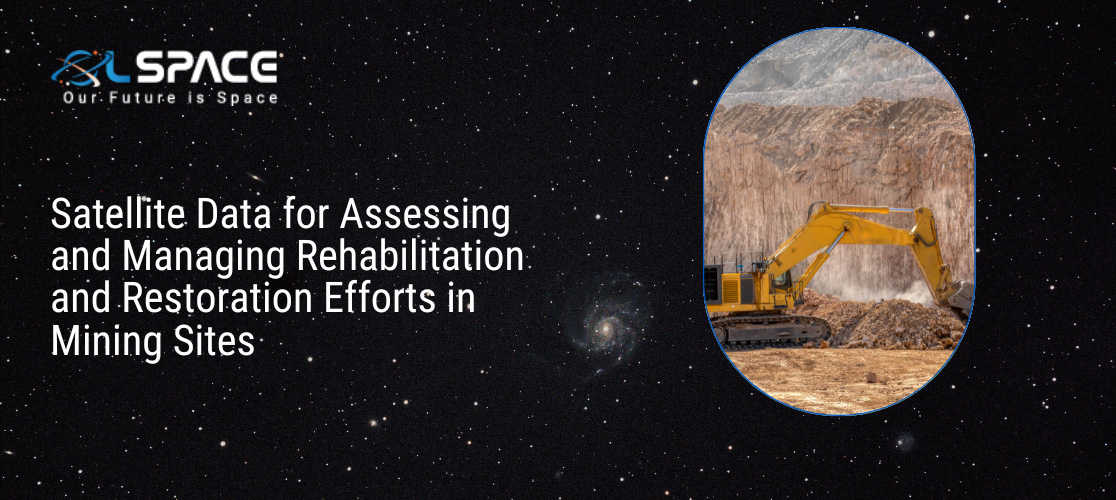16 June 2023
Satellite Data for Assessing and Managing Rehabilitation and Restoration Efforts in Mining Sites

Mining activities often have a significant impact on the environment, leading to disturbances and degradation of land and ecosystems. To mitigate these effects, rehabilitation and restoration efforts are crucial for returning mining sites to a more sustainable and productive state. Satellite data has emerged as a powerful tool for assessing and managing rehabilitation and restoration efforts in mining sites. In this blog post, we will explore the importance of satellite data in monitoring and evaluating the progress of rehabilitation and restoration, as well as its role in guiding effective management practices.
Mapping Land Cover Changes: Satellite imagery provides a comprehensive and objective view of land cover changes over time. By comparing historical and current satellite images, mining companies and environmental agencies can assess the extent of land degradation caused by mining activities and monitor the progress of rehabilitation efforts. Satellite data enables the identification and mapping of vegetation regrowth, changes in land surface, and the restoration of water bodies, helping evaluate the effectiveness of rehabilitation measures.
Monitoring Vegetation Recovery: Revegetation plays a critical role in restoring ecosystem functionality in mining sites. Satellite data can be used to monitor vegetation recovery by capturing the spectral reflectance of vegetation over time. Vegetation indices derived from satellite imagery, such as the Normalised Difference Vegetation Index (NDVI), provide quantitative measures of vegetation health and density. By analysing these indices, mining companies can assess the success of rehabilitation efforts and identify areas that require additional attention.
Assessing Soil Stability and Erosion: Mining activities often result in significant soil disturbances and erosion. Satellite data can be used to assess soil stability and erosion rates by monitoring changes in land surface characteristics. Techniques such as remote sensing of topographic features and analysing surface reflectance patterns help identify areas susceptible to erosion and soil instability. This information enables mining companies to implement targeted erosion control measures and ensure the long-term stability of rehabilitated areas.
Monitoring Water Resources: Effective management of water resources is vital for the success of rehabilitation and restoration efforts in mining sites. Satellite data can provide insights into changes in water bodies, including the extent of water pollution, sedimentation, and changes in water levels. By monitoring these parameters, mining companies can identify areas requiring remediation, implement water management strategies, and assess the success of restoration efforts in terms of water quality and availability.
Quantifying Rehabilitation Progress: Satellite data allows for the quantification of rehabilitation progress by providing accurate and up-to-date information on land cover changes. Geospatial analysis techniques can be applied to satellite imagery to calculate vegetation cover, track land reclamation, and estimate the area of restored habitats. This data can be used to report on the progress of rehabilitation efforts to stakeholders, regulatory bodies, and local communities, fostering transparency and accountability in the mining industry.
Planning and Decision-Making: Satellite data supports informed decision-making by providing valuable information for planning rehabilitation and restoration activities. By analysing satellite imagery, mining companies can identify priority areas for rehabilitation, allocate resources effectively, and develop strategies to optimise land use and biodiversity conservation. Satellite data also facilitates the monitoring of compliance with environmental regulations, ensuring that mining operations align with sustainable development goals.
Conclusion: Satellite data plays a pivotal role in assessing and managing rehabilitation and restoration efforts in mining sites. By providing a comprehensive view of land cover changes, monitoring vegetation recovery, assessing soil stability and erosion, monitoring water resources, quantifying rehabilitation progress, and supporting planning and decision-making processes, satellite data enables mining companies to implement effective strategies for sustainable and responsible mining practices. Leveraging satellite data in conjunction with ground-based assessments and stakeholder engagement enhances the effectiveness and transparency of rehabilitation and restoration efforts, contributing to the long-term environmental and social sustainability of mining operations.
Join our community and never miss an update! Subscribe to our newsletter and blog to stay up-to-date on the latest trends, tips, and insights in your area of interest. Don’t miss out on exclusive content and promotions. Sign up now and be a part of our growing community!
